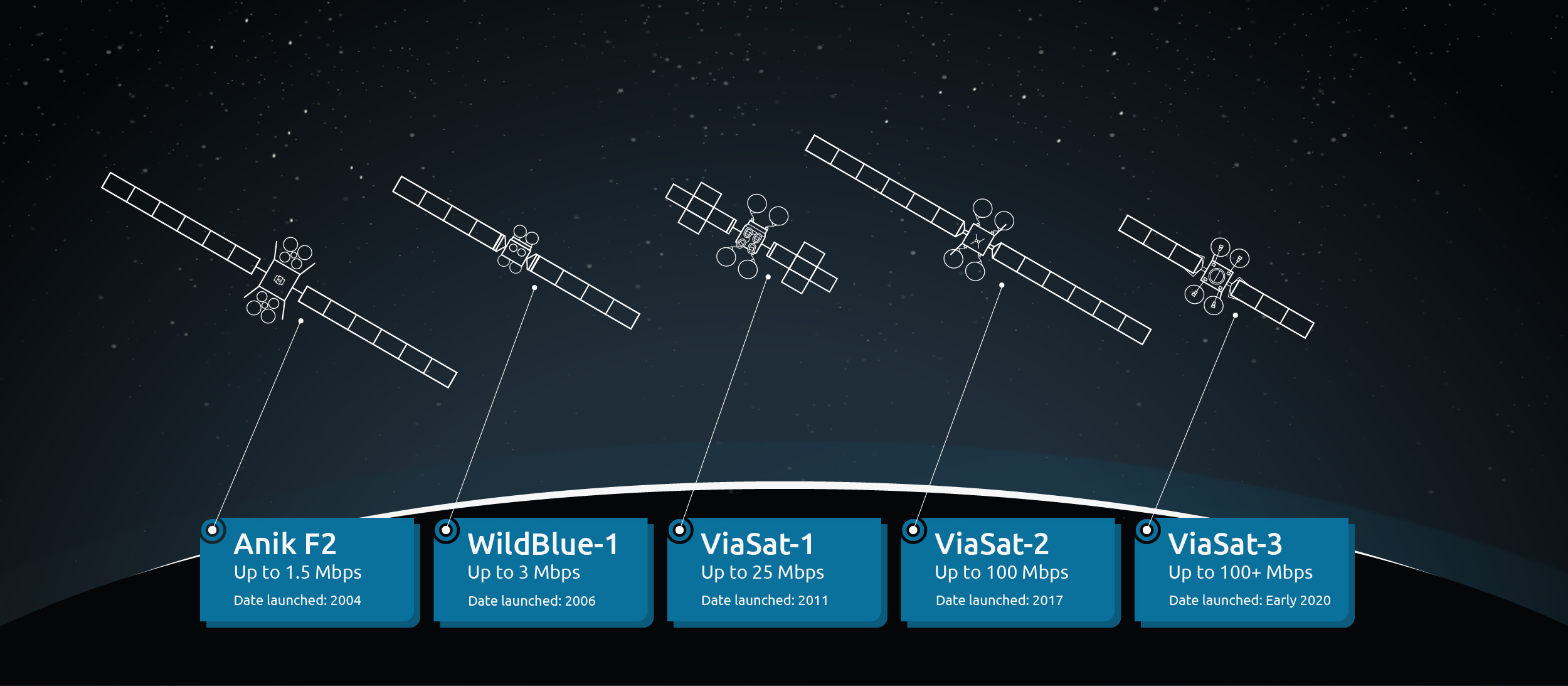Meet the stars of the Viasat network
Slowly but surely building to buzzword status, the term “satellite internet” actually isn’t new—Viasat has offered satellite internet to rural and suburban homes for over 30 years.
Viasat’s tenure doesn’t make the technology outdated, though. To offer internet that’s fun and functional, not stuck in the past, Viasat sends up a new higher-capacity satellite every few years to bring faster speeds to more homes.
Today, the Viasat network runs on four of the satellites pictured above (the Anik F2, WildBlue-1, ViaSat-1, and ViaSat-2), and a new satellite is slated for launch in the early 2020s.
See the evolution of Viasat’s satellite network below.
Anik F-2
In its early days, Viasat teamed up with other companies to offer internet service on a shared satellite network. But in 2004, Viasat launched its own satellite, bringing more internet options to homes still relying on dial-up.
| Download speeds: Up to 1.5 Mbps | Number of satellites: 1 |
| Total network capacity: 2 Mbps | Type of satellite: Geostationary (follows Earth’s orbit exactly) |
| Coverage area: Parts of the US and Canada, including the Far North | Date launched: 2004 |
WildBlue-1
With 3,500 times the total capacity of the Anik-2, WildBlue-1 brought satellite internet service to thousands more homes and businesses in North America. The launch also doubled maximum plan speeds to 3 Mbps, a healthy speed at the time.
| Download speeds: Up to 3 Mbps | Number of satellites: 1 |
| Total network capacity: 7 Gbps | Type of satellite: Geostationary (follows Earth’s orbit exactly) |
| Coverage area: The continental US and parts of Canada and Mexico | Date launched: 2006 |
ViaSat-1
In the early 2010s, the demand for faster speeds grew quickly because people started doing more data-heavy activities (e.g. streaming, video chat, gaming). Viasat launched ViaSat-1 in 2011, giving customers 8 times the maximum plan speed they’d had before.
| Download speeds: Up to 25 Mbps | Number of satellites: 1 |
| Total network capacity: 140 Gbps | Type of satellite: Geostationary (follows Earth’s orbit exactly) |
| Coverage area: The continental US and Canada | Date launched: 2011 |
ViaSat-2
The fastest satellite speeds on the market today come from the ViaSat-2. With maximum speeds of 100 Mbps and unlimited data plans, rural internet customers now have the bandwidth to run their daily lives without running up extra fees.
| Download speeds: Up to 100 Mbps | Number of satellites: 1 |
| Total network capacity: 260 Gbps | Type of satellite: Geostationary (follows Earth’s orbit exactly) |
| Coverage area: North America, Central America, the Caribbean, and aeronautical and maritime routes in the Atlantic | Date launched: 2017 |
ViaSat-3
In the coming years, demands for faster internet will grow as quickly as apps and programs evolve. The upcoming ViaSat-3 launch will offer four times the total network capacity of the ViaSat-2, expanding service to even more areas and bumping the maximum speeds even higher.
| Download speeds: Up to 100+ Mbps | Number of satellites: 3 |
| Total network capacity: 1,000 Gbps (1 Tbps) | Type of satellite: Geostationary (follows Earth’s orbit exactly) |
| Coverage area: North and South America, Europe, Africa, and Asia-Pacific | Launch date: Early 2022 |
About ViasatSavings.com
ViasatSavings.com is an authorized retailer of Viasat.
Send any inquiries to ali@viasatsavings.com.

